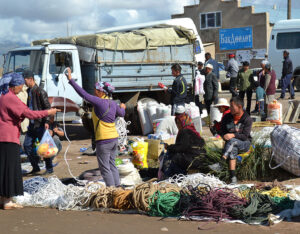Beyond Border Management Programme for Central Asia (BOMCA)

Download “Beyond Border Management Programme for Central Asia (BOMCA)”
EUCAM-Policy-Brief-11.pdf – Downloaded 432 times – 654.40 KBIntroduction
In 2002, Romano Prodi, then President of the European Commission, proudly announced a plan to create a unified border guard for the European Union. Police from various member states would serve together under the EU flag to protect their common external borders. The idea sought to promote a common European identity and to assuage continent-wide fears that the EU’s borders were hopelessly under siege. “We would like to reassure our citizens,” Prodi declared, “that we will protect our borders against terrorism, organised crime and uncontrolled immigration.”(1)
While a common EU border guard has yet to see the light of day, a common EU export strategy has emerged in border management assistance. Such assistance aims to help recipient states strike a healthy balance between open and secure borders. This is not entirely altruistic. As neighbours or near neighbours become better able to control trafficking, extremism, and undocumented migration across their borders, the less likely such activities are to reach the frontiers of the European Union.
Since 2003, the EU has been exporting border management assistance to the Central Asian Republics via the Border Management Programme for Central Asia (BOMCA), which has sought to train border guards, provide key technology and infrastructure at border crossings, and prod states in managing their borders jointly. BOMCA is funded by the European Union and implemented by the United Nations Development Programme through a network of five in-country teams wholly dedicated to BOMCA and the related CADAP programme.
The European Commission is resoundingly enthusiastic about BOMCA, which has achieved much at little cost in a difficult political environment. Indeed, the programme’s continued presence in all Central Asian states is itself a success and measures well in comparison to initiatives in the EU’s Central Asia Strategy for a New Partnership, 2007- 2013. But a circumspect analysis of the programme is necessary if the EU is to make the most of its assistance. With that aim in mind, this brief first outlines BOMCA’s mission and development. A subsequent section takes stock of BOMCA’s achievements and limitations. A concluding section provides recommendations designed to bolster the EU’s impact on border management assistance.
BOMCA and the EU’s Role in Central Asia
BOMCA’s first operations began in Central Asia in 2003, mostly under the direction and sponsorship of the Austrian government. The programme aimed to assist Central Asian states to manage their borders by balancing openness with security; a tough order as many of the states had experienced a number of problems along their frontiers that included trafficking, cross-border terrorism, undocumented migration, and escalation.
Worse yet, the border authorities of Kyrgyzstan, Uzbekistan, Kazakhstan, and Tajikistan (Turkmenistan joined later in 2006) were notoriously uneven in manpower, equipment, training and infrastructure. Uzbek border authorities were highly militarised, prone to closing the border indiscriminately, and found alien the idea of facilitating movement. By contrast, Kyrgyz and Kazakh border authorities lacked proper equipment and entered passport data by hand at official crossings.
In this environment, BOMCA faced its first hurdles. French and Austrian officials in the programme were divided about how best to deploy BOMCA’s limited resources to address the region’s vast border control needs. The programme was besieged with requests from participating countries for border patrol equipment, and its officials ended up pledging equipment many times the amount allowed by the budget. While this created disappointment among some Central Asian authorities, it also served as an early lesson of the region’s operating hazards. BOMCA’s officers would become more adept at processing requests for technical assistance and at deflecting egregious requests by some host governments who thought of the programme as an equipment-bearing gift horse.
The programme’s first major operational challenge came in 2004 as the government of Tajikistan replaced the Russian military units guarding its border with Afghanistan with a ragtag force of Tajik guards.2 BOMCA quickly scrambled to provide an assessment and create a plan of action for the Tajik border. The assessment revealed a total lack of training, equipment, and infrastructure – deficiencies that enabled the trafficking of opiates and precursor chemicals across the border. Moreover, Tajik border guards and customs officials were not accustomed to working together at border crossings and competed for scarce provisions and housing. The exit of the Russian units also had an unforeseen economic effect. The Russian soldiers had set up trading posts at their compounds and used their monthly wages to purchase goods from local traders. The sales monetised the impoverished economy and sustained villages cut off from national markets. When the soldiers left, a number of communities along the frontier were plunged further into poverty.
BOMCA decided to concentrate its first main initiative on the Tajik-Afghan border. While the US military focused primarily on the western sector, BOMCA invested its efforts on remoter sections to the east along Tajikistan’s autonomous Gorno-Badakhshan region.(3) The initiative trained border staff, provided operational handbooks, and equipped border crossings with vehicles, high frequency radios, night-vision equipment, generators, computers, drug-testing kits, and passport readers. The Tajik initiative eventually expanded to higher-order training and building facilities for border authorities. It also provided important lessons that BOMCA carried to future phases.
Among the lessons learned was the need for better coordination. BOMCA did not consult with the Russian government about its plans to revamp the Tajik border, an omission that greatly irked Moscow. Although Moscow decided to remove Russian guards from the border, Russian officials had intended to continue mentoring and provisioning Tajik Border Forces. Consequently, they felt BOMCA’s actions would undermine their influence. In subsequent years, BOMCA’s Dushanbe office held monthly coordination meetings and took great pains to keep the Russian diplomats involved. The Russian FSB team in Dushanbe always attended the monthly coordination meetings and consistently expressed support for the programme. BOMCA’s Tajikistan operations now enjoy a level of Russian support that few other European initiatives in Central Asia can match.
By 2006 BOMCA expanded its plan of action and secured funding from more EU-member states. While this diluted the Austrian imprint of the programme, it gave BOMCA a stronger pan-European identity and enabled it to tackle more activities. Twelve projects comprised the new plan of action ranging from legal reforms in border management to the creation of dog units for drug interdiction, from sponsoring intelligence exchange to mine prevention in border areas (see Box 1).
BOMCA’s five in-country offices are staffed so as to provide in-house expertise on the particular needs of their host state. Each country office comprises a country manager responsible for project implementation and a deputy country manager who steps in when the manager is away on escort duties for training courses, reporting duties to the Commission, or inspection visits to ongoing border projects. A technical engineer is employed to produce specifications for construction projects, and a country team adviser adds either professional border management expertise or deep knowledge of the region’s political and economic dynamics. Meanwhile, BOMCA’s regional management office in Bishkek oversees and coordinates their activities and maintains their activities and maintain the programme’s region-wide focus.
Box 1. BOMCA’s 12 projects
- legal reforms affecting border management
- training for officers in border service management
- regional cooperation in border management
- intelligence sharing across member states
- dissemination of information on border management
- construction of training centres
- establishment of joint border posts to promote synergy
- creation of mobile border control units for remote frontier areas
- creation of dog units for drug interdiction
- professional development of airport authorities
- facilitation of ties between local communities and border guards
- mine prevention in frontier areas
A core component of BOMCA’s action plan is the promotion of Integrated Border Management (IBM) in approximately twenty border crossing points across the region. Most of these points are located in the densely populated Fergana Valley, trisected by Kyrgyzstan, Tajikistan, and Uzbekistan and in the remote Batken Oblast in Kyrgyzstan along the Tajik border. Ferghana hosts lucrative border markets and sees large-scale undocumented crossings that have bred serious tensions between Uzbek authorities, who seal the border to protect the autarchic economy and Kyrgyz authorities, who prefer an open trade border. Batken had seen violent resource conflicts across frontier communities seeking cross-border access to pastures, firewood, and water. It had also served as a conduit for militants from Tajikistan to enter Kyrgyzstan and Uzbekistan.
At these pilot crossing points, BOMCA encouraged the Central Asian states to adopt IBM methods as used by the European Union. IBM consists of three pillars: intraagency cooperation; inter-agency cooperation across a state’s customs, border police, immigration, and military; cross-border cooperation with counterpart agencies. IBMs can have a series of benefits for border management. They lower the costs of border control when contiguous states pool policing resources. They prevent unnecessary escalation by giving border authorities a point of contact with their counterparts so incidents can be resolved locally. They may also prevent corruption by enabling agencies working in shared quarters to monitor one another.
BOMCA intended the IBMs to function as a transformative experience for the Central Asian governments. As one former BOMCA official explains:
“The point is that BOMCA is trying to get the five governments to see border management and border posts not as cost centres gobbling up scarce government budgets, but as revenue generators bringing in much needed customs revenues. Getting the various border agencies to work together can only strengthen this important difference in approach.”
Central Asian officials resisted this idea, partly because of growing tensions in their diplomatic relations but also because their border authorities were often drawn from the military and were thus resistant to cooperation with guards of neighbouring states.
In Central Asia, border management necessarily intersects with counternarcotics. Drug trafficking networks ferry Afghan opiates across the region to markets in Russian and Europe, a trade whose export value across the region approximates several billion euro. Counternarcotics assistance is the purview of Central Asia Drug Assistance Programme (CADAP). CADAP is run by the same five in-country teams who run BOMCA and officials of the two programmes sit in the same offices and often work on both programme action plans. CADAP has provided airports and border crossings with drug detection equipment, legal assistance and training to Central Asian drug enforcement agencies, and training of drug-scenting dogs. The de jure separation of the two programmes keeps BOMCA’s public profile insulated from the issue of cross-border drug interdiction, a task that is fraught with pitfalls given the difficulty of interdiction and massive corruption generated by the drug trade across the region.(4)
In the coming years, BOMCA will expand its focus to promote trade along two corridors: the Fergana Valley corridor, from Osh in Kyrgyzstan to Tashkent in Uzbekistan, and the North- South corridor that will connect Ashgabat with western Uzbekistan, Kazakhstan, and the Russian Federation’s Caspian coast. The trade corridors complement the IBM pilot crossings and the Asian Development Bank’s CAREC programme, a massive $21 billion project that will sponsor the construction of major transport and trade corridors across Central Asia and onwards to markets in proximate regions.(5)
BOMCA recently suffered from a succession crisis concerning its programme manager position. This was triggered when a programme manager of American citizenship was appointed to head the programme in 2008. The citizenship of this otherwise competent manager became an issue within the Commission in Brussels and for several EU ambassadors in Tajikistan who insisted that the top position be held by a European. The departure of the American programme manager left BOMCA in an extended leadership vacuum and wasted time and effort for the UNDP and for the in-country teams that could have been better spent on implementing the project. The ‘American issue’ was put to rest in autumn 2009 with the appointment of a new programme manager of Austrian citizenship and Russian background.
Taking stock: BOMCA’s achievements
BOMCA can boast of a number of achievements in Central Asia: it has provided equipment estimated in millions of euro to Central Asian states. Such equipment includes binoculars, infrared goggles, and thermal cameras that some states may not have been able to procure in the absence of the programme. BOMCA has also provisioned border crossings with more mundane equipment such as refrigerators, which vitally enable border guards to store food and remain at remote posts for extended periods.
BOMCA has sponsored a number of large infrastructure projects across the region. These include crossing terminals along the Kyrgyz-Kazakh border and the construction of border guard housing and customs facilities in remote areas of the Tajik border with Afghanistan. Along the Tajik-Afghan border, the programme coordinated its sponsoring of new border crossings with the location of bridges built across the border by the Aga Khan Foundation. This has enabled border markets to reopen and trade is making a comeback in the impoverished border region.(6)
The programme has facilitated awareness of how national laws can complicate border management. Scores of laws in various Central Asian republics forbid or proscribe agencies from cooperating with their cross-border counterparts. In some instances, the laws also hobble bureaucrats and police from cooperating domestically across essential agencies. BOMCA has lobbied host governments to revise offending legislation.
An undervalued if notable success is BOMCA’s adept engagement with inward-looking states. Uzbekistan and Turkmenistan participate less to procure equipment and more to benefit their international reputations. While these states tend to keep other international programmes at arm’s length – especially those that sponsor democracy and civil society projects – they have been warmer to BOMCA’s rule-of-law, capacity-building, and anti-trafficking agendas. These ties can yield unexpected benefits. Turkmenistan’s former President Niyazov reportedly streamlined the excessive number of checkpoints in border zones after BOMCA officials convinced him that the proliferating checks were redundant, expensive, and counterproductive.
BOMCA has not uniformly fulfilled its entire action plan. It has trained scores of border officials across Central Asia, yet corruption remains rampant. BOMCA’s capacity and budget for training are limited and provide classes and workshops for a small portion of eligible border officers. The new OSCE Border Management Staff College in Dushanbe, launched in May 2009, may go a long way in taking up the slack in training. However, the future relationship between BOMCA and OSCE may not necessarily be one of tight coordination. The college represents a substantial expansion of OSCE activities in the field of border management and this has proven a source of tension with EU-UNDP programmes.
BOMCA has limited success in getting Central Asian authorities to consistently implement practices associated with IBM. Central Asian officials have been reluctant to share intelligence and lists of most-wanted suspects. BOMCA’s efforts to promote joint management have had the most success on the Kazakh-Kyrgyz Ak Jol border crossing near Bishkek. At the Ak Jol crossing, a BOMCA initiative enabled Kazakh and Kyrgyz authorities to perform passport and vehicle checks jointly and simultaneously on one side and greatly expedited traffic. Currently, the two sides have fallen back on separate controls, but it is anticipated that they will return to IBM methods once Kazakhstan introduces a series of measures in anticipation of joining a Customs Union with Russia. The Ak Jol milestone, however, remains the exception rather than the rule along Central Asian border crossings.
Recommendations for the EU and BOMCA
The BOMCA programme is an outstanding model of border control assistance. It is more coordinated and comprehensive than other border management assistance initiatives in the broader region. US assistance to the region, for example, tends to be more piecemeal and focused on paramilitary training. Additionally, BOMCA is cheap relative to its geographic span and thematic scope, covering the Central Asian region for over half a decade for less than €50 million. But the EU can do more to increase its visibility in Central Asia and enhance BOMCA’s work. Here’s how:
- Troubleshoot structural impediments that affect the operations of BOMCA country teams. BOMCA’s success is less due to the unique EU-UNDP collaboration and more to the credit of its country teams who implement their action plans in politically and geographically difficult environments. Projects are often implemented at remote border crossings far from country team offices with less than comfortable accommodations.(7) The work of the country teams can be frustrated with top-down delays in staffing, reimbursement and travel authorisation, procurement of technical supplies, and in locating contractors who are able to do work in remote border posts. All of these require the Commission and UNDP to act more efficiently in meeting the needs of country teams and in coordinating their relationships with one another.
Box 2. Assistance to neighbouring Afghanistan
After years of inaction, the international community has begun to focus on Afghanistan’s woeful border controls. The list of aid sponsors includes the United Nations Assistance Mission to Afghanistan (UNAMA), NATO’s International Security Assistance Force (ISAF), the European Union Police Mission in Afghanistan (EUPOL), the US Departments of Homeland Security, Treasury, and State, and the US military’s Combined Security Transition Command (CSTC-A).
The programmes target a variety of Afghan border management needs: assessment and collection of customs duties; registration of traffic at international crossings; crisis response; drug interdiction; and combat training for guards at remote crossings. US initiatives account for the lion’s share of this assistance. These include CSTC-A a generously funded US military programme that trains and equips Afghan Border Police slated for duty along remote border crossings and the DHS-led Border Management Task Force that oversees pilot programmes for official crossings.
While EUPOL liaises regularly with CSTC-A, the European Union’s imprint on Afghan border management is admittedly minor and can be expanded only if Brussels increases funding for such projects and negotiates a broader role with the US, ISAF, UN and government of Afghanistan. This expansion would be worthwhile as existing aid is concentrated along the eastern border with Pakistan, leaving deficits along Afghanistan’s northern and western borders (respectively with Central Asia and Iran).
- Enhance coordination with other border management assistance sponsors in Central Asia. More states and organisations are sponsoring border management assistance abroad and this includes the Central Asian region where the IOM, Shanghai Cooperation Organisation, and OSCE are increasingly active in border assistance. The OSCE Border Management Staff College in Dushanbe promises to become a major actor in training senior border police and customs officers and it is crucial for all sponsors to dispense assistance efficiently with a minimum of amount of mission creep and tension.
- Encourage advances in border management with tailored rewards. Central Asian states that implement BOMCA’s recommendations and reach critical benchmarks should be rewarded with more EU development aid and infrastructural investments in their border regions. Such incentives may encourage states to fight corruption in police and customs more actively and to adopt more open dispositions to trade.
- Create synergy with border management assistance programmes in Afghanistan. Various members of the international community are currently reforming, expanding, and training Afghan border police and border authorities (see Box 2). The EU should expand the funding of BOMCA and give it the capacity to liaise with border management initiatives in Afghanistan. There is negligible cooperation between the government of Afghanistan and the Central Asian republics in matters of border control despite massive narcotics and arms trafficking along their shared borders. The BOMCA programme could function as a useful vehicle to increase cross-border cooperation.
- Create an EU Fund for Border Management Reform to complement BOMCA’s work. The EU can constitute a fund to which member states and close partners such as Norway and Switzerland might also contribute. The fund could be used for border management projects across a wider geographic scope including Central Asia and also the Caucasus, the Russian Federation, and Afghanistan. A five-year fund totalling €100 million could cover a range of small-to-large border control projects across the above regions, and applications to the fund could be vetted by a committee convened jointly by BOMCA and the OSCE. The fund would heighten the visibility of the EU in border management assistance, make up for lagging EU efforts in Afghanistan, and further engage Russia and other states in win-win projects that benefit common security concerns.(8)
- Qtd. in Peter Andreas, “Redrawing the Line: Borders and Security in the 21st Century,”International Security 21, 2 (Fall 2003): pp. 78-111.
- Russian military units had remained to guard the border with Afghanistan following Tajikistan’s independence from the Soviet Union in 1991.
- This geographic division of labour was intended solely for practical reasons. The border was split into a US and EU sphere of action to ensure border assistance funds were distributed for maximum impact and to make it easier for donors and programme staff to travel to their respective parts of the border.
- For example, the initial provision of drug-sniffing dogs to Tajik authorities proved ill-advised. The dogs were used for breeding purposes rather than drug detection. This generated debate across donors and country teams on how to boost accountability.
- For more information on CAREC (Central Asia Regional Economic Cooperation), see www.adb.org/CAREC.
- In addition to BOMCA, the Border Management Programme for Badakhshan Afghanistan (BOMBAF) is funded by the UK and EU and implemented by UNDP. The programme has funded construction of border posts on the Afghan-Tajik border and equips and trains post staff.
- In Tajikistan, for example, it can take several days of travel to reach some remote, high-elevation border crossings from Dushanbe. Once there, BOMCA teams may have little accommodation available. One former official reports having stayed with families in remote villages and sleeping on mattresses on cold, damp floors.
- On EU-Russian relations and the need for better engagement strategies, see Michael Emerson, Synergies vs. Spheres of Influence in the Pan-European Space (Brussels: CEPS, 2009).







